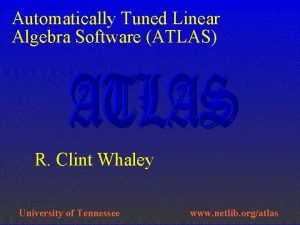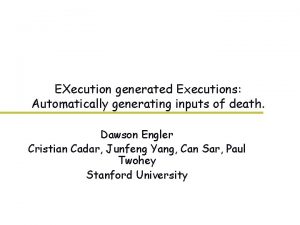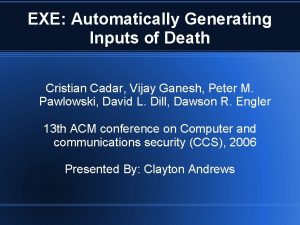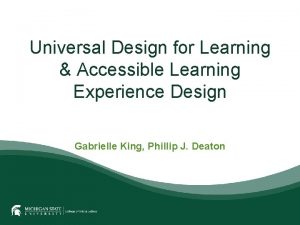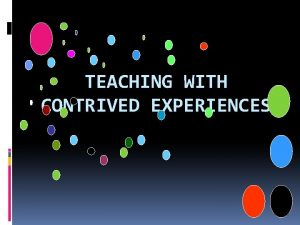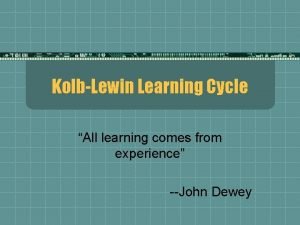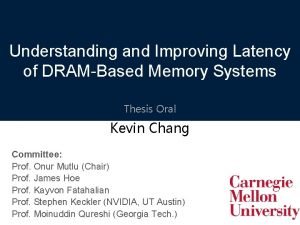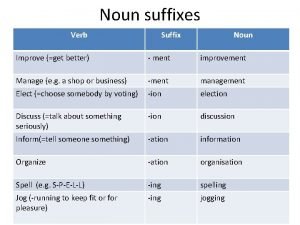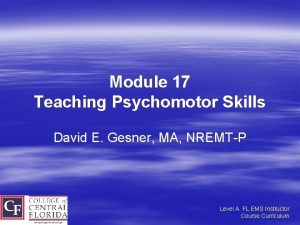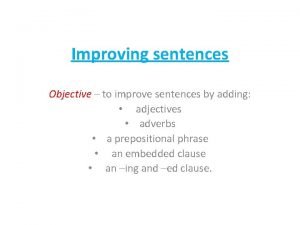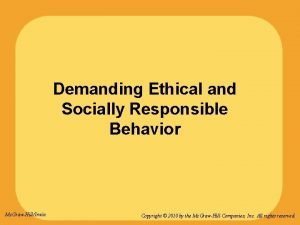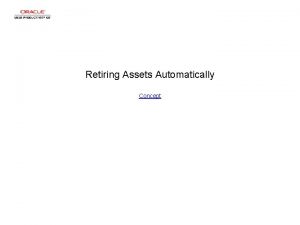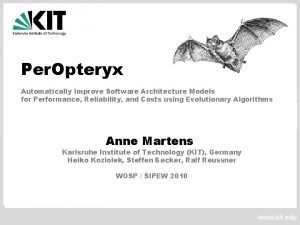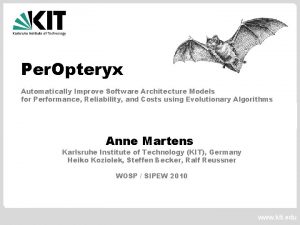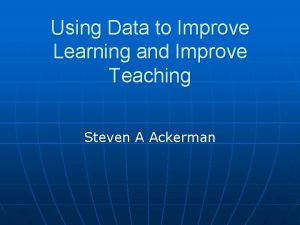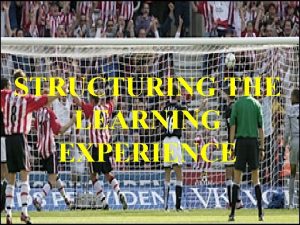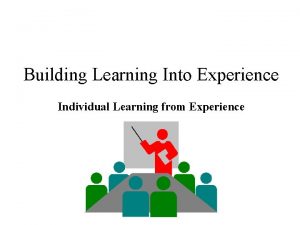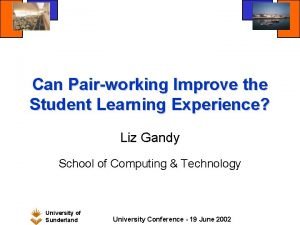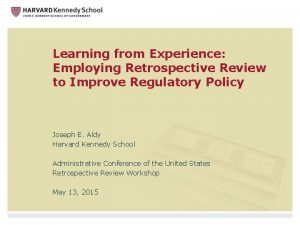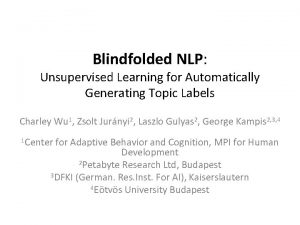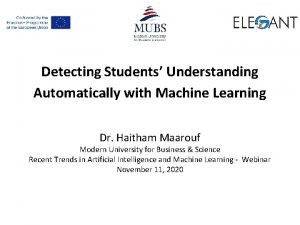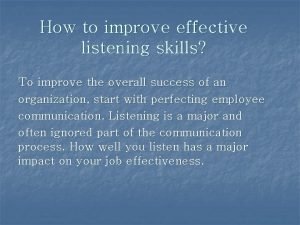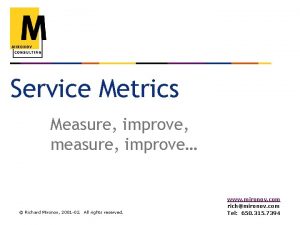What is Learning Learning improve automatically with experience

























- Slides: 25

What is Learning? Learning - improve automatically with experience Using past experiences to improve future performance. 15 CS 73 - Machine Learning 2 1

04/08/2018 How we learn? Rote Learning (memorization) • Memorizing things without knowing the concept/ logic behind them Passive Learning (instructions) • Learning from a teacher/expert. Analogy (experience) • Learning new things from our past experience. Inductive Learning (experience) • On the basis of past experience formulating a generalized concept. Deductive Learning • Deriving new facts from past facts. 3 15 CS 73 - Machine Learning Why Machine Learning? Traditional Programming Data Computer Program Output Machine Learning Data Output Computer Program 4 15 CS 73 - Machine Learning 2

04/08/2018 What is Machine Learning? General definition: • Machine Learning is the field of study that gives computers the ability to learn without being explicitly programmed. Arthur Samuel, 1959 And a more engineering-oriented one: • A computer program is said to learn from experience E with respect to some task T and some performance measure P, if its performance on T, as measured by P, improves with experience E. • Tom Mitchell, 1997 15 CS 73 - Machine Learning 5 What is Machine Learning Machine learning provides systems, the ability to automatically learn and improve from experience without being explicitly programmed. Machine learning focuses on the development of computer programs that can access data and use it learn for themselves. 6 15 CS 73 - Machine Learning 3

04/08/2018 What is Machine Learning The process of learning begins with • observations or data, such as examples, • direct experience, or instruction, in order to look for patterns in data • and make better decisions in the future based on the examples that we provide. The primary aim is to allow the computers learn automatically without human intervention or assistance and adjust actions accordingly. 15 CS 73 - Machine Learning 7 Ex 1: Spam Filtering 15 CS 73 - Machine Learning 8 4

Ex 1: Spam Filtering 15 CS 73 - Machine Learning 9 Ex 1: Spam Filtering Spam filter can learn to flag spam given examples of spam emails (e. g. , flagged by users) and examples of regular (nonspam, also called “ham”) emails. The examples that the system uses to learn are called the training set. Each training example is called a training instance (or sample). In this case, • the task T is to flag spam for new emails, • the experience E is the training data, and • the performance measure P needs to be defined; Ex: ratio of correctly classified emails. 15 CS 73 - Machine Learning 10 5

04/08/2018 Ex 2: A checkers learning problem • Task T - Playing checkers • Performance Measure P - Percentage of games won against opponent • Training Experience E - Playing practice games against itself 15 CS 73 - Machine Learning 11 Ex 3: A handwriting recognition learning problem Task T: recognizing and classifying handwritten words within images Performance measure P: percent of words correctly classified Training experience E: a database of handwritten words with given classifications 15 CS 73 - Machine Learning 12 6

04/08/2018 Ex 4: A robot driving learning problem T: driving on public 4 -lane highways using vision sensors P: average distance traveled before an error (as judged by human overseer) E: a sequence of images and steering commands recorded by observing a human driver 13 15 CS 73 - Machine Learning What is Machine Learning? 15 CS 73 - Machine Learning Traditional Approach 7

What is Machine Learning? Machine Learning Approach Automatically adapting to change ML can help to human to learn 8

04/08/2018 Terminologies Data / Dataset Training Testing Labeled data Training Samples Test Samples Evaluating Samples 15 CS 73 - Machine Learning 17 Dataset: California Home Prices 18 15 CS 73 - Machine Learning 9

Dataset: IRIS 15 CS 73 - Machine Learning 04/08/2018 19 Dataset: MNIST Digits MNIST(Modified National Institute of Standards and Technology database) is a large database of handwritten digits that is commonly used for training various image processing systems. 10 15 CS 73 - Machine Learning

Applications 04/08/2018 15 CS 73 - Machine Learning Visual Object Categorization We are given categories forthese images: What are these? • A classification problem: predict category y based on image x. • Little chance to “hand-craft” a solution, without learning. • Applications: robotics, HCI, web search (a real image Google. . . ) 11

Applications 04/08/2018 Image Classification 15 CS 73 - Machine Learning 23 Applications 12

04/08/2018 Applications 15 CS 73 - Machine Learning 25 15 CS 73 - Machine Learning 26 Applications 13

04/08/2018 Applications Photo tagging 15 CS 73 - Machine Learning 27 Applications 14

04/08/2018 Applications Segment customers and find the best marketing strategy for each group Recommend products for each client based on what similar clients bought Detect which transactions are likely to be fraudulent Predict next year’s revenue Learning from medical records which treatments are most effective 15 CS 73 - Machine Learning 29 Applications Self Customizing programs - houses learning to optimize energy costs based on particular usage patterns of their occupants Personal software assistants learning the evolving interests of their users in order to highlight relevant stories from online newspapers Autonomous driving Speech Recognition 15

04/08/2018 Some successful ML applications Learning to recognize spoken words (Lee, 1989; Waibel, 1989). Learning to drive an autonomous vehicle (Pomerleau, 1989). Learning to classify new astronomical structures (Fayyadet al. , 1995). Learning to play world-class backgammon(Tesauro 1992, 1995). 31 15 CS 73 - Machine Learning Areas/Disciplines influence ML Information Statistics Theory Non-linear elements with weighted inputs (ANN) have been suggested as simple models of biological neurons. Brain Models Linear Algebra Bayesian methods Adaptive Control Theory How best to use samples drawn from unknown probability distributions to help decide fromwhich distribution some new sample is drawn? How to deal with 32 controlling a process having unknown parameters that must be estimated during operation? 16

04/08/2018 Areas/Disciplines influence ML Philosophy How to write algorithmsto acquire the knowledge humans are able to acquire, at least, as well as humans? 15 CS 73 - Machine Learning How to model human performance on various learning tasks? Algorithms and Complexity Artificial Intelligence Calculus Psychology Evolutio nary Models How to model certain aspects of biological evolution to improve the 33 performance of computer programs? Stages in ML process Source: https: //www. gartner. com/binaries/content/assets/events/keywords/cataly st/catus 8/preparing_and_architecting_for_ machine_learning. pdf 17

04/08/2018 Types of Machine Learning 1. Shallow Learning • Algorithms with Few Layers • Better for Les s Complex and Smaller Datasets • Ex: Logistic Regression and Support vector Machines 2. Deep Learning • New technique that usesmany layers of neural network (amodel basedon the structure of humanbrain) • Useful when the target functionis very complex and data sets are very large. 15 CS 73 - Machine Learning 35 Classification of ML algorithms 1. Supervised Learning (inductive) learning • Training data includes desired outputs • X and Y; Given an observation X what is the best label for Y • Example: Classification, Regression problems 2. Unsupervised Learning • Training data does not include desired outputs • X; Given a set of X cluster or summarize them • Example: Clustering 3. Semi Supervised Learning • Training data includes a few desired outputs 4. Reinforcement Learning • Determine what to do based on Rewards and punishments • Example: Robot movement, Game AI 15 CS 73 - Machine Learning 36 18

Supervised Learning - Classification 04/08/2018 Source: http: //www. java-machine-learning. com/blog/supervised-learning/ Unsupervised Learning-Clustering 15 CS 73 - Machine Learning 19

04/08/2018 Unsupervised Learning-Clustering http: //www. java-machine-learning. com/blog/unsupervised-learning/ 15 CS 73 - Machine Learning 39 ML – Types of Learning Source: http: //www. embedded-computing. com/embedded-computing-design/analytics-driven-embedded-systems-part-2 -developing-analytics-and-prescriptive-controls 15 CS 73 - Machine Learning 40 20

04/08/2018 15 CS 73 - Machine Learning 41 Why is ML is Important? Sometasks cannot be defined well, except by examples (e. g. , recognizing people). Relationships and correlations can be hidden within large amounts of data. Machine Learning/Data Mining may be able to findthese relationships. Human designers often produce machines that do not work as well as desired in the environments in which they are used. The amount of knowledge available about certain tasks might be too large for explicit encoding by humans (e. g. , medical diagnostic). 15 CS 73 - Machine Learning 42 21

04/08/2018 Why is ML is Important? Environments change over time. New knowledge about tasks is constantly being discovered by humans. It may be difficult to continuously re-design systems “by hand”. 15 CS 73 - Machine Learning 43 Skills required for ML Engineer 1. Mathematical Skills • Probability, Statistics, Linear Algebra, Calculus 2. Programming Skills • Coding, Algorithms, DS, OOPs • Python, R, Matlab, Java 3. Data Engineering Skills • Data Preprocessing, Analysis, Visualization 4. Knowledge of ML algorithms • Shallow and Deep learning • Supervised, Semi-Supervised, Unsupervised, Reinforcement 5. Knowledge of ML Frameworks • Sci. Kit Learn, Tensorflow, Caffe, Theano, Spark, …. many more 15 CS 73 - Machine Learning 44 22

04/08/2018 In summary, ML is great for: Problems for which existing solutions require a lot of hand-tuning or long lists of rules: one Machine Learning algorithm can often simplify code and perform better. Complex problems for which there is no good solution at all using a traditional approach: the best Machine Learning techniques can find a solution. Fluctuating environments: a Machine Learning system can adapt to new data. Getting insights about complex problems and large amounts of data. 15 CS 73 - Machine Learning 45 Some issues… What algorithms can approximate functions well and when? How does number of training examples influence accuracy? How does complexity of hypothesis representation impact it? How does noisy data influence accuracy? What are theoretical limits of learnability? How can prior knowledge of learner help? What clues can we get from biological learningsystems? How can systems alter their own representations? 15 CS 73 - Machine Learning 46 23

04/08/2018 Where we are? 47 15 CS 73 - Machine Learning Text and Reference Books Tom M. Mitchell, Machine. Learning, India Edition 2013, Mc. Graw Hill. T Hastie, RTibshirani, JFriedman The Elements of Statistical Learning, Springer Ethem Alpaydın, Introduction to machine learning, 2 nd edition, MIT press. 15 CS 73 - Machine Learning 48 24

04/08/2018 Are you concerned about the increase in Machine Learning and Artificial Intelligence? No, but I’m concerned about the decrease in real intelligence. 49 15 CS 73 - Machine Learning Thank you 15 CS 73 - Machine Learning 50 25
 Automatically tuned linear algebra software
Automatically tuned linear algebra software Exe: automatically generating inputs of death
Exe: automatically generating inputs of death Exe: automatically generating inputs of death
Exe: automatically generating inputs of death Imprint definition psychology
Imprint definition psychology Continuity vs discontinuity
Continuity vs discontinuity Direct experience vs indirect experience
Direct experience vs indirect experience Accessible learning experience design and implementation
Accessible learning experience design and implementation Integrative learning experience
Integrative learning experience Contrive experiences
Contrive experiences Language experience activity
Language experience activity Learning comes from experience
Learning comes from experience Cuadro comparativo de e-learning b-learning y m-learning
Cuadro comparativo de e-learning b-learning y m-learning How to improve marketing performance
How to improve marketing performance Improve memory latency
Improve memory latency Intrapersonal vs interpersonal
Intrapersonal vs interpersonal Ways to improve urban infrastructure
Ways to improve urban infrastructure Current ratio high or low better
Current ratio high or low better Improve as a noun
Improve as a noun Advertise suffix
Advertise suffix How to improve psychomotor skills
How to improve psychomotor skills If you can't measure it you can't control it
If you can't measure it you can't control it Kiss keep improve start stop
Kiss keep improve start stop Improvement of software economics
Improvement of software economics Boring sentences to improve
Boring sentences to improve Taste 2. hali
Taste 2. hali Www.reachoutworld.org/amc
Www.reachoutworld.org/amc
